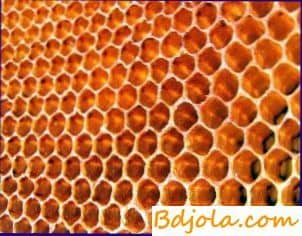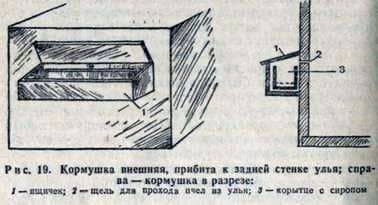
Many beekeepers of large industrial farms, realizing the inevitability and high efficiency of fertilizing, are seeking ways to reduce labor on distribution of food to bees. In bee-breeding farms, it is necessary to feed the families-educators daily during all without honey-gathering days. It is necessary to feed the fathers’ families in order to prevent the untimely expulsion of drones. For the production of packet bees, it is necessary to force the brood rearing early in the spring, when there is no honey collection yet, and it is impossible to achieve this without feeding.
In the honey-commodity apiaries, periodical top dressings are also effective in places where there is no spring supporting honey.
External (extra-lure) feeding troughs. A lot of time when giving fertilizing is required for the removal of roofs and insulating pillows. These works can be avoided if you strengthen the feeders outside the hives (hanging feeders). From the feeders of this type are most convenient arranged in the form of light boxes that are attached to the back wall of the hive.

The external dimensions of the box: length – 20-25 cm, height – 10-12, width – 8 cm. Side walls of the box are beveled. On top, the box is closed with a lid made of a thick board, fixed on hinges. With its weight, it covers the box tightly. In the back of the box there are 2 loops, with which it is hung on 2 nails, driven into the wall of the hive. The walls of the box on the inside are doused with wax or paraffin. In the back wall of the box and the hive make a through hole for the passage of bees from the hive into the feeder. Food is not poured into the box, but in the trough (with the fuser), inserted into the box. The fact is that no matter how tightly the box has been knocked down, it under the influence of the sun, moisture, fluctuations in temperature, shrinks, warps. Through the formed slits there will be a forage, and this will cause the theft of bees.
To pour food into the hanging feeder, it is enough to lift the lid, which must then be tightly closed again.
The external feeder has one drawback: in cold weather, the food quickly cools, and the bees take it badly or even refuse to take it at all. Therefore hinged feeders have spread mainly in the south of the country, and use them only for the frequent distribution of small quantities of feed in the warm season.
The diagram of the device for distributing food in the hives is shown in Figure 20. A syrup tank (1) is put in the body of the scooter, which is fed into the hose (3) by the pump (2), terminated by a dispensing valve (4). If the valve is closed, the syrup will return to the tank (1) through the hose, ending with the drain valve (5).
For the supply of fluid, an engine oil pump is used, which is equipped with a sealing gland. The pump capacity (D-54) is 20 liters per 1 minute, the head is up to 1 atm. The dispenser type OK has a capacity of about 30 liters per minute. The pump drive is connected by a V-belt drive with the power take-off shaft of the scooter motor. To do this, the end of the elongated roller of the main reducer is pulled out.
The scooter is stopped by a group of hives so that 2 hoses reach up to 6-9 hives. The gear lever is moved to neutral and includes a high gear. The end of the hose is inserted into the hole of the feeder and, after opening the hose, pouring the food. The amount of food can be dosed by the stopwatch. After giving feed to the whole group of families, the motor scooter moves to the next group of hives. In the distribution of food should be 2-3 people.

The scooter is also used in the apiary to distribute feed to the intrawrow feeders, but it takes much longer.
To distribute the feed, a motorized cart used in gardens and orchards and equipped with a pump for spraying trees can be used.
Polyethylene bags can be used as a container for feeding bees. The best results are given by bags of a film 0.1 mm in thickness, 30X45 cm in size. This bag holds up to 5 liters of sugar syrup.
In the bag pour the syrup on 3/4 of the volume, after which the free edges are bent and the remaining air is completely removed. The edges of the bag are glued together with a hot iron or rubber (sticky) tape used in electrical engineering. It is very important that there is no air left in the bag, then its walls will fall as the feed is taken and the bees will always have access to it.
The prepared (sealed) pouches are placed on top of the hive frame and then at the top of the pouch with a nail tip 3 mm thick make holes through which the bees take the forage. At the same time, from a single hole, feeds from 6 to 10 bees can be taken. The number of holes depends on the strength of the family and the purpose of feeding. If the feed is given as stimulating for the brood rearing, then make 3-4 holes, so that the bees take it gradually for a long time (up to 20 days). In this case, the family will take 250 grams of feed per day. If feed is given to replenish feed stocks, then the number of holes is increased several times. To speed up the picking up of food, you just need to increase the number of holes, but in any case do not expand the holes.
For convenient placement of the pouch on the upper shell of the hive, it is necessary to put an empty semicontract or podkryshnik, above which lay a wooden ceiling and a warming pillow.
With the use of polyethylene bags, you can continuously supply bees with small doses of feed without spending a lot of time on it.
Fill the bags with food in the workshop, where this process can be greatly simplified, using the necessary tools. This method of feeding bees has found wide distribution in industrial apiaries of Australia.
As an incentive feeding in recent years, the Distribution of the sugar beet test (kandi) to Bees is becoming more widespread . With such a top dressing, no feeders or any other equipment is required; give out food quickly. In the candy, you can add the necessary stimulating or medicinal substances that will reach the bees evenly for a long time.
For the preparation of candy in large farms it is necessary to have a ball mill to receive powdered sugar powder, and a kneader to mix candy.
Содержание пчел в павильонах. Отделы тела у пчелы.
Feeding base of beekeeping